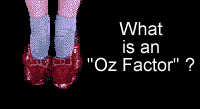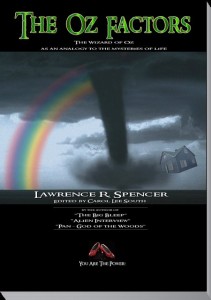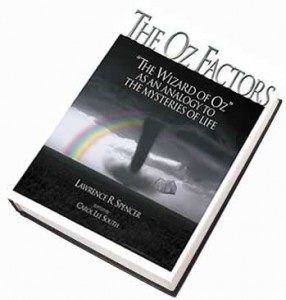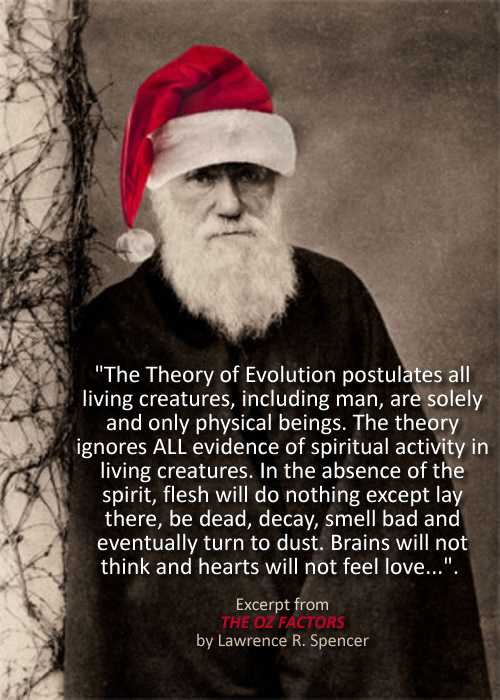Republished by Blog Post Promoter
Category Archives: THE OZ FACTORS
“The Oz Factors” is a book which reveals the 12 common denominators of civilization that prevent mankind for discovering workable solutions to the problems of life. The Oz Factors was written by Lawrence R. Spencer and published in 1999.
RUBY SLIPPERS
Republished by Blog Post Promoter
 “Take special care of those Ruby Slippers. I want those most of all!” — The Wicked Witch of the West in ‘The Wizard of Oz’
“Take special care of those Ruby Slippers. I want those most of all!” — The Wicked Witch of the West in ‘The Wizard of Oz’
Definition: Vested Interest–1/ a survival or non-survival plan or agenda which has been “clothed” to make it seem like something other than what it actually is; 2/ any person, group or entity which prevents or controls communication to serve their own purposes.
Example: Governments control communication between the people of their country. You must get a passport to travel to another country. You must pass through a customs’ inspection in order to enter the country. You must pay taxes (money is a form of communication). You must get a license to get married or go into business.
Example: Religions prevent and control communication between people and the gods, saints and spirits. You have to pay the priest money for him to “bless” you or to “absolve” you of “sin” as a supposed representative of the god(s).
Example: A husband usually tries to prevent communication between his wife and other potential lovers.
What would happen if you could safely communicate with everything and everyone?
Political, religious and financial vested interests, typically, DO NOT want people to answer this question. The reason is simple: if you could safely communicate with anyone or anything, they would be out of business!
Such institutions very frequently determine what we are allowed to believe by feeding us their version of “the truth”. Our “belief” in their version of “the truth” is usually backed up by the threat of death, imprisonment, excommunication or bankruptcy.
All human beings have flesh bodies. Flesh bodies require food, shelter, clothing and as many other goods and creature comforts as one can buy, borrow or pillage. This seems to be a common denominator of survival. It is also a source of illogical thinking which has tended to clog the water mains of our minds with all manner of unspeakable refuse: namely, our vested interest in survival.”
__________________________
Excerpt from THE OZ FACTORS, by Lawrence R. Spencer
THE OZ FACTORS: EBOLA SURVIVAL TIPS
Republished by Blog Post Promoter
http://in5d.com/100-benefits-of-ozone-therapy.html
Buy your own Ozone generator for water AND air for less than $200.00 on the following links:
———————————————–
“EBOLA – CIA Project Codename MKNAOMI & Hi-Tech Assassinations In 1948, Henry Kissinger, a 23-year-old American intelligence officer, recruited Nazi expatriates to serve in top positions in American military, aerospace, and biological science and medicine. Twenty years later, he left Harvard’s esteemed faculty and resigned a lucrative position as Nelson Rockefeller’s foreign policy attache’ to become President Nixon’s closest advisor and director of the National Security Council. Seeking alternatives to tactical nuclear weapons to bolster America’s “diplomacy” abroad, the paranoid and egomaniacal Kissinger quickly ordered the Army’s Chief of Staff to requisition $10 million from Congress for the development and testing of EBOLA & AIDS-like viruses. Within ten years, the AIDS and Ebola epidemics erupted coincidentally in the regions of Africa ravaged by CIA military covert operations also ordered by Kissinger.
In 1948, Henry Kissinger, a 23-year-old American intelligence officer, recruited Nazi expatriates to serve in top positions in American military, aerospace, and biological science and medicine. Twenty years later, he left Harvard’s esteemed faculty and resigned a lucrative position as Nelson Rockefeller’s foreign policy attache’ to become President Nixon’s closest advisor and director of the National Security Council. Seeking alternatives to tactical nuclear weapons to bolster America’s “diplomacy” abroad, the paranoid and egomaniacal Kissinger quickly ordered the Army’s Chief of Staff to requisition $10 million from Congress for the development and testing of EBOLA & AIDS-like viruses. Within ten years, the AIDS and Ebola epidemics erupted coincidentally in the regions of Africa ravaged by CIA military covert operations also ordered by Kissinger.
In 1984, Dr. Robert Gallo, of the National Cancer Institute, claimed credit for discovering the AIDS virus. He announced it most likely originated from a monkey virus which spontaneously mutated and naturally jumped species. Dr. Gallo was a biological weapons contractor for the CIA’s top secret “Project: MKNAOMI,” and was paid to produce and test EBOLA, AIDS-like viruses as early as 1970.
EBOLA – CIA Project Codename MKNAOMI & Hi-Tech Assassinations”
The following is an excerpt about AIDS and EBOLA from my book THE OZ FACTORS, published in 1997:
“Over the past two decades, we have come to realize that AIDS can have a latency period, during which no symptoms appear, during which it remains undetectable by tests. This latency period can be from ten to 18 years. It can hide in bone marrow or brain tissue, while still being transmitted to others. The virus can be transmitted by casual, non-sexual contact via saliva, blood and perhaps, even through mosquito bites which transfer infected blood from one person who is already infected to another person according to some sources.
Because the virus adapts itself genetically to the DNA structure of each person, there are as many strains of HIV as there are individual people. Thus, so-called HIV testing, which is done in clinics and hospitals, cannot detect the presence of the virus in most people.
On July 29, 1969, only days after the United States Department of Defense requisitioned ten million dollars from Congress to fund the development of AIDS-like viruses, the House Republican committee, chaired by George Bush of Texas, (before he became head of the CIA, and later, the President) cited the urgent need for population control activities to fend off “a growing Third World crisis”. This “concern” for population control is at the root of the United State’s Third World foreign policy.
Several important intrigues regarding this United States Third World foreign policy are exposed in Dr Leonard Horowitz’s book, ‘Emerging Viruses–AIDS & Ebola’, including:
1/ President Nixon’s special presentation before the Population Conference in which he appealed for urgent action;
2/ Economic, military, and “humanitarian” policies and projects implemented under Nixon and Carter;
3/ Subsequent World Bank, NASA, and the National Academy of Sciences (NAS) activities in Africa;
4/ Henry Kissinger’s leading role in establishing and directing African foreign policy and “diplomatic” affairs;
5/ WHO and USAID (United States Agency for International Development) together sponsoring immunization programs in central Africa; and,
6/ American intelligence connections to USAID and African health care initiatives.
Horowitz details the sequence of events which led to the murder of millions of black Africans under the covert direction of the “New World Order”.
The investigations by Dr Horowitz and others have uncovered the mysterious rise of Henry Kissinger to prominence in America’s intelligence community. Kissinger’s relationships with the Rockefellers, Richard Nixon, Alexander Haig, and other Nixon White House officials have now been exposed along with his leading role in the development of nuclear and biological weapons.
Henry Kissinger, the darling of the Rockefellers, was the architect of the philosophy and purpose of the “New World Order”, as articulated by President Bush, and advanced in Kissinger’s 1955 Harvard PhD thesis, ‘The Meaning of History’. Kissinger argued that there will never be peace on earth. Instead, he called for a stable economic order of nations which could be maintained by creating small, ongoing wars with financial advantages for weapons developers.
Kissinger was appointed by Nelson Rockefeller to head the nuclear weapons study group of the non-governmental Council on Foreign Relations in 1955.
Kissinger (an avowed supporter of the Nazi Party as a 16-year-old in Germany) was appointed as National Security Advisor–the most influential position in the Nixon White House. The alternate choice for the post was none other than Roy Ash, the President of Litton Industries. Litton Industries military contracts, during the first Nixon administration, exceeded five billion dollars! Ten million of those dollars went to Litton Bionetics, the Biological Weapons contractor with whom Robert Gallo worked to develop AIDS-like viruses at that time.
After his great power grab, Kissinger’s first act as Director of National Security was to order Alexander Haig and J Edgar Hoover to wiretap Nixon and others, thus producing the infamous “White House tapes”.
Kissinger had absolute control over the Defense Program Review Committee (which considered the funding requests for biological weapons), and absolute control over the 40 Committee, an intelligence advisory committee which authorized covert actions by the CIA in Central Africa in the vicinity where AIDS and Ebola first broke out.
Increasing evidence has been accumulating which demonstrates that the CIA not only co-opted the Executive Branch of the United States Government while being directed by Dr Henry Kissinger during the Nixon era, but apparently carried out efforts to replace J Edgar Hoover.
All this was going on at the same time Kissinger was directing the CIA to continue escalating foreign and domestic espionage operations, which was directed against black Africans and American homosexuals.”
VIEWER BEWARE
Republished by Blog Post Promoter
The video clip (below) is an excellent example of the reason that we cannot trust ANYTHING we see on film, video, television, Facebook, etc. to be “real”. The art of Computer Generated Imaging (CGI) in the film and television industry is now so highly developed that the viewing audience cannot distinguish between reality and fantasy. When this technology is applied as intentional disinformation in the hands of those who desire to confuse and control us, let the Viewer beware! How do we know what is “true”. How can we determine what is intentional disinformation or propaganda?
Here is a excerpt from the book THE OZ FACTORS that addresses this subject:
“5/ SHE FELL FROM A STAR
“Come out, come out, wherever you are and meet the young lady who fell from a star … “–Glinda sings to the Munchkins in ‘The Wizard of Oz’
False information, less diplomatically stated, could be called lies. Sometimes lies are unintentional. Sometimes lies are intentional. Regardless, false is false, and we need to inspect all the information we receive to ensure that it is not false.
One way to know if information is false is to determine whether the information helps us achieve a workable solution or does it lead toward continued mystery.
Such scrutiny may seem obvious, but few people critically examine information they receive. Whether the information has to do with the meaning of life or how to bake a better chocolate chip cookie, it is wise to put the information to the test before using it to develop any theories or before taking action based upon it.
Logically, before we go skipping down the Yellow Brick Road into the unknown, a few simple precautions might prove useful.
Precaution 1: Does the information contain actual statistics or documented evidence or is it just a broad, sweeping generalized statement?
The morning newspaper headlines have propagandized a recent political effort to take guns away from the citizens with broad, general statements like: “Street gangs are sweeping the country! The youth of America are all killing each other with illegal handguns!”
 Of course, no violent deaths are acceptable. But, when was the last time you personally observed a street gang shoot-out? Check out the facts: In 1990 there were 971 black youths and 942 white youths under the age of 18 who were victims of homicide in the United States. Hardly an epidemic compared to a total of 9,923 total people killed with handguns in the same year.
Of course, no violent deaths are acceptable. But, when was the last time you personally observed a street gang shoot-out? Check out the facts: In 1990 there were 971 black youths and 942 white youths under the age of 18 who were victims of homicide in the United States. Hardly an epidemic compared to a total of 9,923 total people killed with handguns in the same year.
By contrast, 12,400 people were killed by accidental falls. So, why don’t the newspapers have headlines about “The Terrible Tragedy of Gravity”?
More than 28,642 people committed suicide in 1990 and 69,225 died of pneumonia or flu. Cigarette smoking was a major killer with 78,380 deaths from emphysema. Meanwhile, in a real, honest-to-god-epidemic, 476,927 people died of cancer! How much effort is being made by the propaganda machines of big government to prevent smoking which is one of the principle causes of cancer?
False information is also spread simply by failing to include all of the correct information or including too much information.
Precaution 2: Does the information help your survival? Is it destructive? Is it just plain upsetting?
Asking the news media to report “the truth” is like asking a fly crawling on a cow pie for an accurate description of the cow. The kind of information we receive from the morning news on television or in newspapers or ‘Time’ magazine is, factually, very often highly spin-doctored, altered and misinterpreted. The so-called “news” is nothing more than a very tiny slice of the most shocking, disastrous, upsetting, tragic, gruesome, inhumane events which these sources painstakingly cut from the relatively large and lovely pie of life. This “news” is gathered from isolated sources, at great expense and selectively edited using the most sensationally colored prose imaginable. Yet the mainstream media news neglect to report the fact that billions of people and billions of other life forms on this planet are enjoying happy lives–no thanks to them!
Does reading or hearing about every single psychopathic rape/murder/theft/mayhem/disaster that occurs anywhere on the entire planet really improve the quality of your life or happiness? Or is this information you can more happily live without?
6/ THE RUBY SLIPPERS
“Take special care of those Ruby Slippers. I want those most of all!”–The Wicked Witch of the West in ‘The Wizard of Oz’
Definition: Vested Interest–1/ a survival or non-survival plan or agenda which has been “clothed” to make it seem like something other than what it actually is; 2/ any person, group or entity which prevents or controls communication to serve their own purposes.
Example: Governments control communication between the people of their country. You must get a passport to travel to another country. You must pass through a customs’ inspection in order to enter the country. You must pay taxes (money is a form of communication). You must get a license to get married or go into business.
Example: Religions prevent and control communication between people and the gods, saints and spirits. You have to pay the priest money for him to “bless” you or to “absolve” you of “sin” as a supposed representative of the god(s).
Example: A husband usually tries to prevent communication between his wife and other potential lovers.
What would happen if you could safely communicate with everything and everyone?
Political, religious and financial vested interests, typically, DO NOT want people to answer this question. The reason is simple: if you could safely communicate with anyone or anything, they would be out of business!
Such institutions very frequently determine what we are allowed to believe by feeding us their version of “the truth”. Our “belief” in their version of “the truth” is usually backed up by the threat of death, imprisonment, excommunication or bankruptcy.
All human beings have flesh bodies. Flesh bodies require food, shelter, clothing and as many other goods and creature comforts as one can buy, borrow or pillage. This seems to be a common denominator of survival. It is also a source of illogical thinking which has tended to clog the water mains of our minds with all manner of unspeakable refuse: namely, our vested interest in survival.
Survival requires stuff, and stuff costs money and money takes work. This often means that we must each pretend to “like” someone or “believe” in something–that we could actually care less about–for the sake of “earning a living”.”
Boardwalk Empire VFX Breakdowns of Season 2 from Brainstorm Digital on Vimeo.
The Emmy award-winning team at Brainstorm Digital has put together the before and after shots from season 2 of HBO’s hit series “Boardwalk Empire”. (courtesy of Home Box Office, Inc) www.brainstorm-digital.com. Twitter: @BrainstormVFX.
THE OZ FACTORS: NEW AUDIOBOOK AVAILABLE NOW
Republished by Blog Post Promoter
Listen to a Sample:
The Oz Factors: The Wizard of Oz as an Analogy to the Mysteries of Life

Our humanity has long since been exceeded by the power of the wicked witches of science and government to destroy all life with nuclear weapons, alter our DNA and control our minds with psychotropic drugs and our lives with media lies.
Our thoughts and conjectures about life and the universe are often based on assumptions, unproven theories, hearsay, rumors and misinformation. Decisions we make in life may be based on ancient attitudes and archaic practices.
There are 12 common denominators that prevent observation, understanding, and workable solutions to problems of existence. How do each of these ‘Oz Factors’ influence our history, science, philosophy, our lives and our future?
We can chose our own Yellow Brick Road. We can pull back the curtain of rhetoric and dogma. We can build a better Emerald City for ourselves and our children.
Do you really want to go back to Kansas?
http://www.audible.com/pd/ref=sr_1_1?asin=B00B25HTUQ&qid=1358802443&sr=1-1


